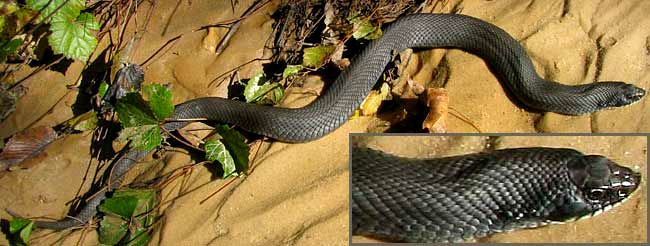Excerpts from Jim Conrad's
Naturalist Newsletter

from the December 2, 2001 Newsletter, from near Natchez, Mississippi
HOGNOSE SNAKE
Monday morning next to our coldframe I was surprised by an Eastern Hognose Snake, HETERODON PLATYRHINOS, sunning himself next to a bale of hay. "Surprised" is putting it mildly since this species makes a living from looking mean. Though its coloration is extremely variable and some individuals are completely black like the one shown above, photographed later several miles away, this one was boldly patterned like a Timber Rattler and thick like a Cottonmouth. My heart fluttered a bit before my brain took over and made a proper identification.
Making a proper identification was important because hognose snakes are among Nature's most spectacular bluffers. They are perfectly harmless critters but they look and behave as if they could chew your leg off. And the bold patterns and bright coloration of my Monday snake are only part of that bluffing.
The first thing my hognose did to increase my terror was to flatten himself. Basically hognoses are medium-size snakes, but when they spread themselves they look much more powerful than they are. When Monday's hognose saw that I wasn't running away he increased his apparent size even more by taking in an enormous amount of air and thus ballooning his body, and spreading his head into a dangerous-looking triangle, exactly like an Indian cobra. He even hissed!
This show did not prevent me from nudging my little friend with a finger, for I knew he would not bite. I have had hognoses strike at me, but they don't open their mouths. It's all pure bluff. I nudged Monday's hognose for a reason, for I wanted to see the last part of his performance.
Sure enough, after the nudge the poor snake flipped onto his back, held his mouth agape, let his tongue hang out, and just laid there, as dead-looking as a snake could possibly look. Of course, when I flipped him onto his stomach he promptly went onto his back again, and with that his repertory of responses was exhausted. You can see a very pitiful-looking "death-feigning" hognose at the bottom of the page at the above-mentioned address.
The body-flattening, air-imbibing, hood-flaring, hissing and final death scene are as inevitable with this species as its habit of eating toads and frogs -- except that tamed individuals stop going through the routines once they realize they do no good. As a kid in Kentucky when I saw my first Eastern Hognose I was sure that I'd discovered a circus escapee, a real death-dealing cobra. However, when I got out my books I learned that hognoses are a fairly common species in nearly all of the eastern US, except in the far north.
It's a wonderful snake but I fear that many have been slaughtered by humans impressed in the wrong way by their bluffing.